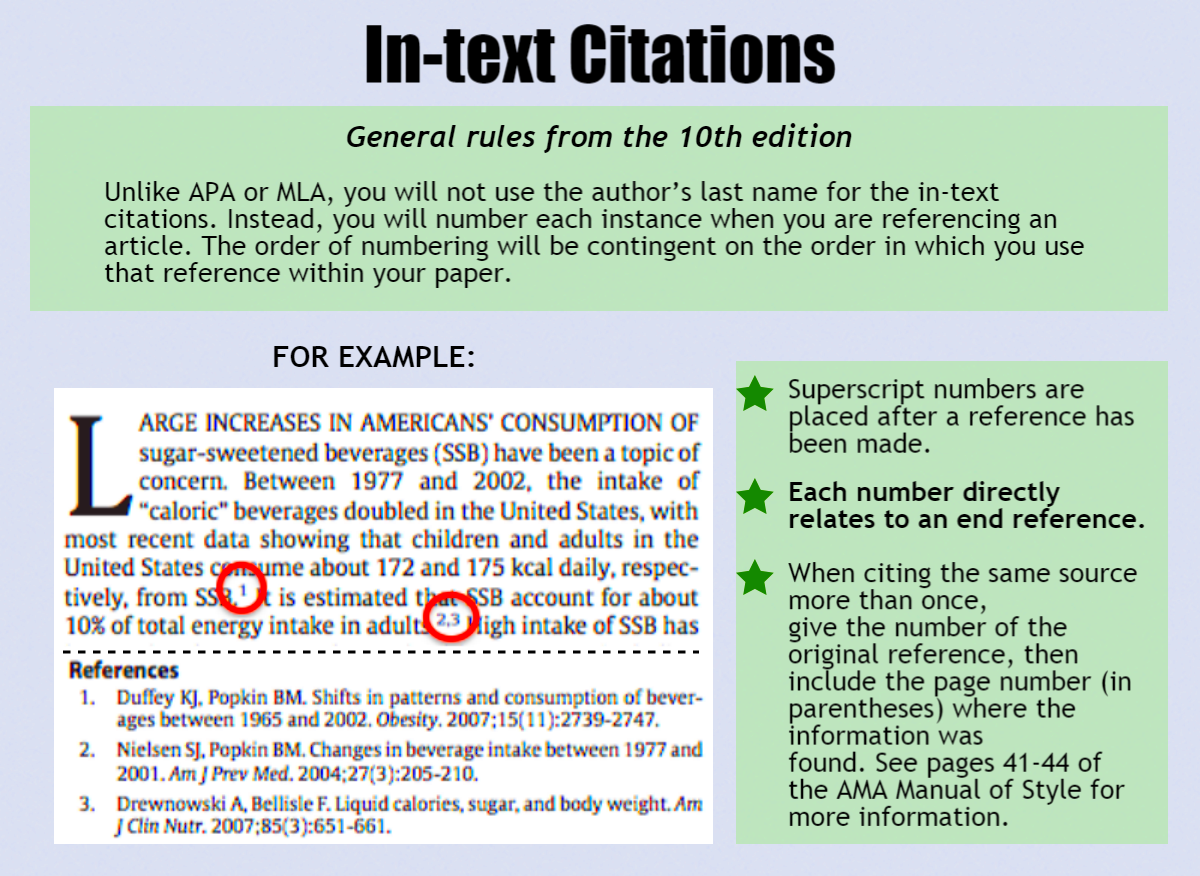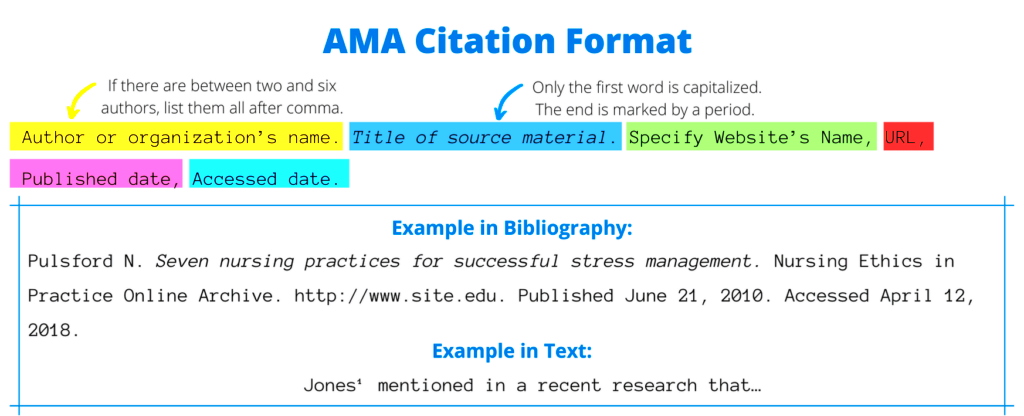When using images for academic, professional, or personal purposes, it's important to give credit where it's due. Citing images in the AMA (American Medical Association) format is essential for maintaining the integrity of your work and acknowledging the original creators. This format ensures that your citations are clear, consistent, and easily accessible to readers. Whether you're working on a research paper, a presentation, or an online article, knowing how to cite images properly is crucial.
Understanding AMA Citation Style for Images

The AMA citation style is commonly used in medical and scientific writing, and it includes specific guidelines for citing visual elements such as images, figures, and tables. Unlike other styles like APA or MLA, AMA focuses on providing precise and concise details to make it easy for readers to find the original source.
When citing an image in AMA format, the basic structure involves the following components:
- Author(s): The person or organization who created the image.
- Title of the Image: A brief description or title of the image, if available.
- Source: Where the image was retrieved from, such as a website or a book.
- Publisher: The organization or entity that published the source.
- Year: The year the image was created or published.
- URL: If the image is online, include the direct link to the image.
Here’s a general example of an AMA citation for an image:
Author(s). Title of image. Source. Publisher; Year. Available at: URL. Accessed [date].
Also Read This: How to Caption Getty Images Correctly
Why Citing Images Correctly is Important
Proper citation of images is crucial for several reasons. First and foremost, it respects intellectual property rights. Creators of images, whether photographers, illustrators, or institutions, have the right to be credited for their work. By citing images correctly, you avoid plagiarism and ensure that the original authors or sources are recognized.
Additionally, citing images accurately helps maintain the credibility of your own work. It shows that you’ve conducted thorough research and that you value the sources you've used. A well-cited image also allows readers to trace the source material, making your work more transparent and trustworthy.
Here’s why it matters:
- Intellectual Property Protection: Citing images ensures you respect copyright laws and avoid legal issues.
- Credibility: Proper citations give your work authority and trustworthiness.
- Accountability: If readers want to verify your image, they can easily find the original source.
In academic or professional contexts, following citation rules helps you avoid any potential issues with plagiarism. For students and researchers, this is particularly important as improper citation can lead to academic consequences. It’s a simple way to demonstrate ethical research practices.
Also Read This: Downloading Images from Candy AI: A Step-by-Step Guide
Step-by-Step Guide to Citing Images in AMA Format
Citing images in AMA format may seem complex at first, but it’s straightforward once you break it down into simple steps. Whether you're working with online images, photographs from a textbook, or medical diagrams, following these steps will ensure your citations are correct and complete.
Here’s a step-by-step guide:
- Step 1: Identify the Creator of the Image
Start by finding the author or creator of the image. This could be an individual or an organization, like a museum or a website. If the creator is unknown, use the title of the image as the author. - Step 2: Include the Title of the Image
Provide a clear and concise title for the image. If the title is not available, provide a description instead. Be sure to format the title in italics. - Step 3: Source of the Image
State where you found the image, whether it’s a website, journal, or book. If it's a website, provide the specific page or section where the image is located. - Step 4: Publisher and Year
For books or journals, list the publisher and the publication year. For online sources, the year the image was published or created should be included. If no year is available, use "n.d." (no date). - Step 5: URL and Access Date
If the image was found online, include the URL where the image can be accessed. Also, provide the date you accessed the image if it’s an online source that might change over time.
Putting it all together, your citation will look like this:
Author(s). Title of image. Source. Publisher; Year. Available at: URL. Accessed [date].
Also Read This: How to Use Getty Images for Free: Exploring Legal Options for Free Access
Examples of AMA Image Citations
Now that you understand the structure, let’s look at some examples of how to cite images in AMA format. Below are some typical scenarios you might encounter when citing images.
Example 1: Citing an Image from a Website
Smith J. Diagram of the human circulatory system. Encyclopedia of Human Biology. Oxford University Press; 2020. Available at: https://example.com/circulatory-system. Accessed November 15, 2024.
Example 2: Citing an Image from a Book
Johnson M. Medical illustration of human bones. Medical Anatomy for Students. Springer; 2018.
Example 3: Citing an Image from a Journal Article
Doe A, Green P. X-ray image of knee joint fracture. Journal of Medical Imaging. 2023; 45(6): 320-322.
Example 4: Citing an Image from an Unknown Author
Untitled image of city skyline. Cityscapes: A Global View. National Geographic Society; 2021. Available at: https://example.com/city-skyline. Accessed November 15, 2024.
These examples cover a variety of image sources and show how to format your citations accurately, making it easier for readers to locate the original image.
Also Read This: How Can I Sell Photos on Getty Images: A Beginner’s Guide to Starting as a Contributor
Common Mistakes to Avoid When Citing Images
Even with the right format, it's easy to make mistakes when citing images. These errors can affect the accuracy and credibility of your work. Here are some common mistakes to watch out for and tips on how to avoid them:
- Omitting Image Creator: Always ensure you include the author or creator’s name. If the creator is unknown, provide a description instead.
- Incorrect or Missing Year: If you can’t find the publication year, make sure to use "n.d." for no date, rather than leaving it blank.
- Forgetting to Include the URL: When citing online images, the URL is crucial. Without it, your citation is incomplete. Always check that the link is correct and works.
- Not Using Italics for Titles: Titles of images should always be italicized. Failing to do so can make your citation look inconsistent and unprofessional.
- Not Including the Access Date: For images retrieved from the web, you must include the date you accessed them, as online content can change over time.
By being mindful of these common mistakes and checking each citation carefully, you’ll ensure your image citations are both accurate and professional.
Also Read This: How to Make Money from Getty Images and Build a Successful Photography Business
How Getty Images Downloader Helps in Proper Image Citation
Using the Getty Images Downloader tool can greatly simplify the process of citing images correctly in AMA format. When you download an image from Getty, the tool often provides helpful metadata that includes the creator, publication date, and other important citation details, making it easier to format your reference accurately. Here’s how it helps:
- Automatic Citation Information: Getty Images Downloader provides the necessary metadata such as the photographer’s name, image title, and publication date, reducing the chances of missing important details.
- Easy Access to Source Details: When you download an image, the source URL is typically embedded, so you don’t have to manually look up the website or source from where the image came.
- Convenience: The downloader lets you access high-quality images quickly without having to worry about manually formatting each citation. You can focus more on your work, knowing the citation information is accurate.
- Consistency: By using Getty Images Downloader, you can ensure your citations follow a consistent format, as it helps gather all the essential information for a complete AMA citation.
For researchers, bloggers, or students, this tool streamlines the image citation process, ensuring proper credit is given while saving time on formatting. It’s a valuable resource for anyone who needs to adhere to AMA guidelines while incorporating images into their work.
Also Read This: How to Purchase iStock Images for Your Sketch Projects
Frequently Asked Questions About Citing Images in AMA Format
Citing images in AMA format can raise many questions, especially if you're new to the style. Below are some of the most common questions people have when it comes to image citations in AMA format.
Q1: How do I cite an image from a website?
A1: To cite an image from a website, you need to provide the creator’s name (if available), the title or description of the image, the source (website), the publisher, and the URL. Don’t forget to include the date you accessed the image if it’s an online source.
Q2: What if there is no author for the image?
A2: If the image does not have a clear author, use the title of the image (or a description if no title is provided) in place of the author’s name. For example: “Untitled image of a landscape.”
Q3: How do I cite a figure or table from a textbook?
A3: When citing a figure or table from a textbook, include the creator (author of the book), the title of the book, the publisher, the publication year, and the page number where the figure or table appears. AMA requires you to include the specific page for clear reference.
Q4: Do I need to cite the image if it’s in the public domain?
A4: Yes, even if an image is in the public domain, you should still cite it properly to give credit to the creator and provide your readers with the source of the image.
Q5: What if I can't find the publication date?
A5: If you can’t find the publication date for an image, use "n.d." (no date) in place of the year in your citation.
Conclusion and Final Thoughts on AMA Image Citations
In conclusion, citing images in AMA format is essential for ensuring proper credit to the creators, maintaining academic integrity, and providing clarity for readers who may want to explore the original sources. By following the AMA guidelines and understanding the necessary components, you can cite images correctly and avoid any pitfalls.
Remember, citing images doesn’t just apply to academic papers – it's a good practice for anyone who uses images online, in presentations, or in professional materials. The Getty Images Downloader tool can be a helpful resource for gathering all the citation details you need, making the process quicker and more efficient.
To summarize:
- Proper Image Citation: Always cite the creator, source, and publication details.
- Accuracy is Key: Double-check your citations to avoid mistakes, especially when dealing with online images.
- Use Tools Like Getty Images Downloader: These tools make citing images easier by providing accurate metadata and citation details.
With a little attention to detail, citing images in AMA format can be an easy and seamless process, allowing you to focus on the content of your work while maintaining professionalism and respect for the original creators.

 admin
admin








